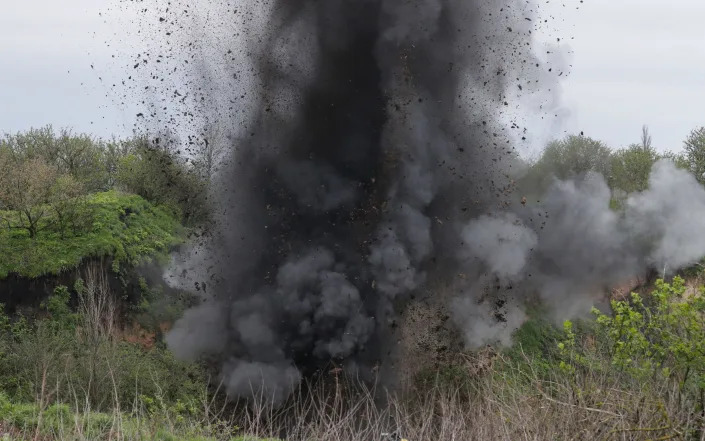The Telegraph
Russia’s losses are worse than anyone thinks
Hamish de Bretton-Gordon – May 9, 2023

It was a curious sight. Russia’s annual Victory Day parade, a display of military might and a celebration of its role in defeating Nazi Germany, could only muster a solitary T-34. The serried ranks of tanks seen in recent years were absent; many of them will be lying burned out in the Donbas. Putin’s speech, meanwhile, was desperate, even delusional. He claimed civilisation was “at a decisive turning point”; that a “real war has been unleashed against Russia”; that the West seeks the “disintegration and destruction” of Russia. The only person driving towards that goal is Putin himself.
His army is in a shambolic condition, with multiple reports indicating that troops are fighting without adequate body armour. Young men are conscripted and thrown into the meat grinder of the Donbas, backed by antiquated tanks. They face forces combining modern Western equipment with significant new tactical innovations. And they are being slaughtered.
Over the last century, battlefield casualties for Western forces have seen a steady decline. Modern medical techniques, antibiotics and military developments have all played their role. But assumptions based on this experience may not work when estimating the losses suffered by Putin’s poorly-equipped conscripts.
Ukrainian reports of Russian casualties resemble something from the fronts of the First World War, with hundreds killed and injured each day. Western analysts have tended to be more conservative in their estimates.
But this conflict is not like those we have seen previously. Kyiv’s forces are innovating new ways of conducting warfare, with drones at their heart. Tech savvy young men and women are repurposing and re-engineering for the battlefield off-the-shelf and inexpensive equipment developed for peace.
This is a game changing moment. Russia’s armed forces are centred around the use of artillery; various sources list Moscow’s expenditure of shells as multiples of Ukraine’s. And yet even pessimistic assessments show a casualty ratio skewed heavily in Ukraine’s favour, despite being theoretically outgunned.
The key to this appears to be innovation. What is unique to the Ukraine conflict is the use of both drones as striking weapons and as platforms for observation. Some analysts suggest that using the standard ratios of deaths/wounded will be very far from reflecting the lethality of this new mode of warfare. Some have gone so far as to suggest that the vast majority of artillery rounds and mortar shells fired by Kyiv’s forces will be watched by drone, allowing for – in artillery terms, at least – pinpoint accuracy.
And the pace of change is set to continue. The Ukrainians have trained 10,000 drone operators, who will add to Kyiv’s capability to observe and guide indirect fire. This type of attack was called precision targeting when I first went to Afghanistan in 2008. In those days we would have a huge Nimrod aircraft with 20 or so operators on board, flying at 20,000ft with a single camera. There would be five or six of us on the ground monitoring the live feed; if the right target was identified we called in a precision air strike from a fighter jet. We conducted a few of these strikes per week. Later, we moved on to Reaper drones with hellfire missiles. But these strikes were rare; what Kyiv is doing is new.
Fighting a battle for national survival, every tank or enemy combatant is a fair target. the Ukrainians are developing techniques not only focused on precision attack but also on directing artillery fire. Battlefield footage may look like the First World War – trenches, shells and casualties abound – but we have moved on from rare balloon spotters sending messages to guns. Now, there are hundreds of tiny drones with amazingly capable cameras, giving detailed pictures and highly accurate meta data back to the guns. This is a type of warfare which few in Nato have ever experienced; when Russian casualty rates as estimated by the West appear to be half what the Ukrainians are claiming, it is surely possible that the Ukrainians are right.
This is backed up by the scramble in Russia to find soldiers. Both sides might lack ammunition, but the Kremlin appears to be running out of soldiers to fire that ammunition. The long-term costs for Russia are likely to be devastating.
Col Hamish de Bretton-Gordon is a former commander of the 1st Royal Tank Regiment
